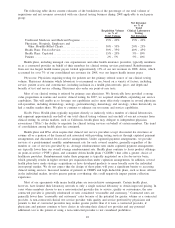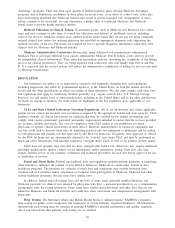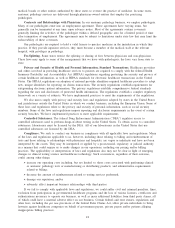Quest Diagnostics 2008 Annual Report Download - page 23
Download and view the complete annual report
Please find page 23 of the 2008 Quest Diagnostics annual report below. You can navigate through the pages in the report by either clicking on the pages listed below, or by using the keyword search tool below to find specific information within the annual report.We also may be a member of a “complementary network.” A complementary network is generally a set of
contractual arrangements that a third party will maintain with various providers that allow for discounted fees for
the benefit of members of the customers that arrange access through the third party. A member of a health plan
may choose to access a non-contracted provider that is a member of a complementary network; if so, the
provider will be reimbursed at a rate negotiated by the complementary network.
We attempt to strengthen our relationships with health plans and increase the volume of testing services by
offering health plans services and programs that leverage our Company’s expertise and resources, including in
such areas as wellness and disease management.
Hospitals and Other Laboratories. Hospitals generally maintain an on-site laboratory to perform the
significant majority of clinical testing for their patients and refer less frequently needed and highly specialized
procedures to outside laboratories, which typically charge the hospitals on a negotiated fee-for-service basis. Fee
schedules for hospital reference testing typically are negotiated on behalf of hospitals by group purchasing
organizations. We provide services to hospitals throughout the United States, including esoteric testing, helping
manage their laboratories and serving as the medical directors of the hospital’s histology or clinical laboratory.
We believe that we are the industry’s market leader in servicing hospitals. Hospitals generally continue to look
for ways to fully utilize their existing laboratory capacity: they perform tests their patients need and compete
with commercial laboratories for outreach (non-hospital patients) testing. Continuing to obtain referrals from
hospitals depends on our ability to provide high quality services that are more cost-effective than if the hospitals
were to perform the services themselves. We believe that our combination of full-service, bi-coastal esoteric
testing capabilities, medical and scientific professionals available for consultation, innovative connectivity
products, point-of-care testing products, focus on Six Sigma quality and dedicated sales and service professionals
has positioned us to be an attractive partner for hospital customers.
Most physicians have admitting privileges or other relationships with hospitals as part of their medical
practice. Many hospitals seek to leverage their relationships with community physicians by encouraging the
physicians to send their outreach testing to the hospital’s laboratory. In addition, hospitals that own physician
practices generally require the physicians to refer tests to the hospital’s affiliated laboratory. Hospitals can have
greater leverage with health insurers than do commercial clinical laboratories, particularly hospitals that have a
significant market share; hospitals thus are frequently able to negotiate higher reimbursement rates with health
insurance plans than commercial clinical laboratories for comparable clinical testing services.
We also have joint venture arrangements with leading integrated healthcare delivery networks in several
metropolitan areas. These joint venture arrangements, which provide testing for affiliated hospitals as well as for
unaffiliated physicians and other local healthcare providers, serve as our principal laboratory facilities in their
service areas. Typically, we have either a majority ownership interest in, or day-to-day management
responsibilities for, our hospital joint venture relationships.
We also provide testing services to federal, state and local governmental agencies, and perform esoteric
testing services for other commercial clinical laboratories that do not have a full range of testing capabilities.
These customers are charged on a fee-for-service basis.
Employers. Employers use clinical tests for drugs-of-abuse to determine an individual’s employability and his
or her “fitness for duty.” Companies with high turnover and safety conscious environments provide the highest
volumes of testing. Factors such as the general economy and job market can impact the utilization of clinical
testing. We seek to grow our employer volumes through offering new and innovative programs to help companies
with their goal in maintaining a safe and productive workplace. We also offer employers our Blueprint for
Wellness program, providing wellness screenings to employers for their employees, to help employers manage
increasing healthcare costs and to capitalize on trends in personalized health.
GENERAL
Competition. While there has been significant consolidation in the clinical testing industry in recent years,
our industry remains fragmented and highly competitive. We primarily compete with three types of clinical
testing providers: hospital-affiliated laboratories, other commercial clinical laboratories and physician-office
laboratories. Our largest independent clinical laboratory competitor is Laboratory Corporation of America
Holdings, Inc. In addition, we compete with many smaller regional and local commercial clinical laboratories,
specialized esoteric laboratories and laboratories owned by physicians and hospitals. In anatomic pathology,
additional competitors include anatomic pathology practices, including those in academic institutions. In addition,
there has been a trend among specialty physician practices to bring pathologists into those practices.
11
























